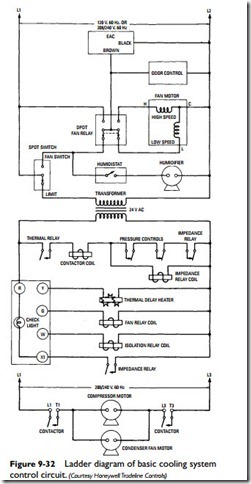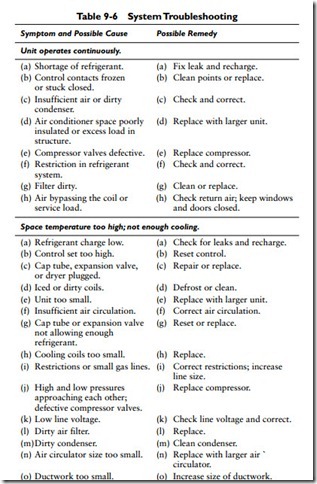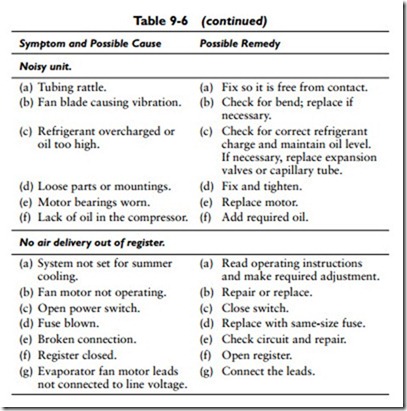General Servicing and Maintenance
It must be thoroughly understood that the greatest precautions must be taken to exclude air and moisture from a refrigeration system and that it should not be opened to the atmosphere without first removing the refrigerant from that part of the system to be serviced or repaired.
Caution
Always shut off the electrical power to the air conditioner at the disconnect switch before performing any maintenance or repairs.
The air conditioner may have multiple power supplies.
Regular Maintenance
Extend the service life and operating efficiency of the air-conditioning equipment and system by providing regular maintenance. A regular maintenance schedule should include the following:
• Clean the indoor evaporator coils.
• Clean the outdoor condenser coils. Use a water hose to flush the outdoor condenser coils.
• Check the coils for leaks with a leak detector.
• Clean or replace the indoor unit filter.
• Check wiring and contacts for loose connections, corrosion, and/or damage.
• Check the amp draw at the outdoor fan motor and the indoor blower motor and compare the values to those on the unit nameplate.
• Check the voltage at the indoor and outdoor units with the units operating.
• Check the system for the correct amount of refrigerant.
• Inspect the condensate drain line for blockage and clean as necessary.
• Check the ducts for leaks and repair if found.
• Oil motors and check belts for tightness and wear.
• Check for the correct electrical control sequence.
Pumping Down
Whenever a refrigeration system is to be opened to the atmosphere for service operations or repairs, it is necessary to remove the refrigerant from that part of the system to be opened. By pumping down the system prior to servicing, the refrigerant can be saved.
The manufacturer of the equipment will usually include detailed instructions concerning the pump-down procedure. Read and follow these instructions carefully.
Pumping down the system usually involves confining the refrigerant to the receiver by closing off the liquid line stop valve and (with a gauge attached to the intake stop valve) operating the compressor. By doing this, all the gas is drawn back to the compressor and condensed in the condenser but is prevented from going further by the liquid line stop valve.
The compressor should be run until the suction pressure is reduced to holding steady at approximately 2 to 5 lbs pressure. Do not draw a vacuum on the system. A vacuum will cause moisture to be drawn into the system when it is opened.
Purging
Purging refers to the release of air or noncondensable gases from a system, usually through a cock placed on or near the top of the receiver. This term is also applied to the sweeping of air out of a newly installed part or connection by releasing refrigerant gas into the part and allowing it to escape from the open end, thus pushing the air ahead of it.
Follow the instructions for purging contained in the manufacturer’s installation and operating literature.


